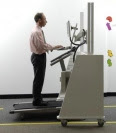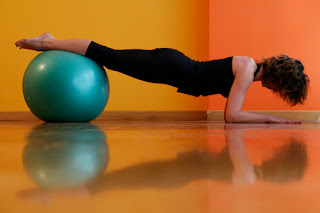are where God wants us…”
AAOMPT Loses a Fellow
are where God wants us…”

Critical observations of health, science, and the physical therapy profession.
 A new research study by James Levine describes the effects of implementing an upright, treadmill desk for office workers. The desk is designed so that workers can stand up and walk on the treadmill as they do their work. The goal of this is to increase calorie expenditure throughout the year, thus minimizing worker obesity. In the study, workers walked 35 minutes out of each hour, burning about 100 calories an hour more than usual. The Wall Street Journal Health Blog asked Dr. Levine some questions about this.
A new research study by James Levine describes the effects of implementing an upright, treadmill desk for office workers. The desk is designed so that workers can stand up and walk on the treadmill as they do their work. The goal of this is to increase calorie expenditure throughout the year, thus minimizing worker obesity. In the study, workers walked 35 minutes out of each hour, burning about 100 calories an hour more than usual. The Wall Street Journal Health Blog asked Dr. Levine some questions about this.
The radiological image on the left is a femoral Osteoid Osteoma. On the right is a T8 compression fracture. Both of these images are CT scans. The military clinic where I work affords Physical Therapists the privilege of being able to order imaging like this when needed. This is an ability not available to Physical Therapists who do not work in military settings.
The person with knee pain had displayed a gradual onset of pain in his left knee. He was vague in locating the area where the pain was felt. There was no injury or event that provoked the pain and the knee had some mild swelling despite all special tests for mechanical structures returning a negative result. In other words, my clinical exam could not determine what was wrong.
The “muscle spasm” patient was even more tricky. There was a well documented incident where the patient, a nurse, had assisted in a transfer and felt pain and spasm immediately. The transfer was a simple slide up in the bed and seemed to have no ability to create any sort of serious injury. There was some red flags, however: extreme tenderness and protection upon palpation and the inability to sleep due to aching pain.
On both of my requests for radiology I included the term, “rule out underlying pathology.”
I was glad I did, and even more grateful for my ability to have access to these tests. Neither case was an emergency, but I fear that if I saw these same two patients in a civilian clinic, I might have been tempted to try a few session of therapy before deciding to send them back to their physician for more tests, which might or might not happen, and could take several weeks!

Last week I stumbled upon a fun game. I happened to read this post from Seth Godin, marketing guru of the information age. He detailed the sometimes overwhelmingly positive effects that good press in the Times can have on business. Shortly thereafter, I noticed a piece in the Times about Physical Therapy.
The NY Times has a nice feature where certain words are hyperlinked to other articles on the subject, all within their own website. It’s easy to see what the Times thinks of Physical Therapy, just click on the word Physical Therapy and see what you get. Alternatively, you can search the archives when the short-lived hyperlinks are removed from the article. I did that and found an interesting collection of articles in which the term “Physical Therapy” appeared.
My favorite was written by Jane E. Brody, after she apparently had a personal experience with Physical Therapy. Her article focused on “Good Therapy…”
“I have also learned a lot about how to judge the quality of physical therapy. As one reader, Tina Mosetis of Great Neck, N.Y., noted, “Most therapists do not spend enough time analyzing what is wrong with the patient, and after the initial session they simply direct the patient to do exercises on the gym equipment.”
While interesting, I think the most interesting fact returned by this exercise is that the results returned only 75 articles that included the term “Physical Therapy” since 1981. That same search for “Physician” returns 5,136 articles.
Perhaps what the New York Times thinks of Physical Therapy is that it doesn’t consider us very good promoters of our trade? And, if you haven’t yet noticed, the article pictured above that started this whole game was featured in the Fashion and Style section! What’s that about?
 Last night, the Midlands District of the South Carolina APTA was treated to a nice lecture from Stacy Fritz, PT, PhD, a professor at University of South Carolina, during our biannual meeting.
Last night, the Midlands District of the South Carolina APTA was treated to a nice lecture from Stacy Fritz, PT, PhD, a professor at University of South Carolina, during our biannual meeting.
Her topic was something she calls Intensive Mobility Training (IMT). It describes a type of Physical Therapy intervention in which individuals with chronic neurological impairments are given intense (as the name suggests!) therapy utilizing some very interesting principles. The therapy essentially pairs components of two unique neurological interventions, Locomotor Training (LT) and Constraint-Induced Movement Therapy (CIMT).
Among the principles that this therapy is based on, one captured my imagination: the concept of massed practice. Essentially, this motor learning theory groups the learning for a task into one small period of time with an enormous amount of repetition during that time. An example would be 2 weeks of 3-6 hours of therapy daily, in which the majority of time spent was performing the desried task repetitvely, i.e., walking. This is in contrast to more traditional rehab schedules, such as 3 times a week for 60 minutes over 8 weeks.
While I was listening to the talk, I had a difficult time wrapping my brain around the possible scenario in which an insurer would ever pay for such time periods of therapy, which sometimes includes multiple therapists working on one patient. Well, research like this may help to answer a question that is just so obvious as to be often neglected:
“What evidence supports how much therapy a patient requires?”
Perhaps research like this might one day pave the way for a “revolution” in how Physical Therapy services are provided with respect to time and dosage. I know one thing for sure: without evidence like this, insurance companies will be all too eager to keep us locked into the current time-based payment scale!
Aside from her informative lecture on IMT, I learned two things I was not expecting to:
1. South Carolina leads the nation in incidence of stroke.
2. The incidence of Spinal Cord Injury in SC is 20% higher than the national average.
At least the drug companies are not alone in buying off doctors. This time it is a criminal investigation into ortho docs who have been paid handsomely by device manufacturers to use their implants. No one is accusing these docs of compromising patient safety, but it is illegal to accept kickback payments AND be a Medicare provider.
This reminds me of a recent conversation I had with an orthopaedic resident (I am summarizing the conversation for obvious purposes):
ME: “How many of these surgeries do you plan to do?”
RES: “Well we’ve not been doing too many, but my attending is good friends with the sales rep from company B, so we will probably stop using company A and do more surgeries with B’s implant.”
ME: “Oh, he’s friends with the guy?”
RES: “Yeah, they go fishing, and my attending stays at his cabin. They go on trips
all the time.”ME: “I didn’t realize that implant had FDA approval yet!”
RES: “It doesn’t, but I think we’re kind of holding 0ff on surgeries
using company A while we wait for company B’s implant to get it.”

The Top 5 Physical Therapist Recommended Body Hacks:
1. Repair your posture by fixing your muscle strength and overall fitness, NOT by sitting up straight.
If I had to pick one muscle that I wished was more flexible in any of the bodies I treat, I would surely pick the hamstrings. These play a role in how you walk, as well as back, knee, and hip pains. Their health and ability to function has a lot to do with how athletic you are. The hamstring muscles cross two joints, making them big players in the precise control of your lower limb. Please never let them get tight, or stay that way. Stretch! For personalized care and expert guidance on maintaining muscle health, physical therapy Roanoke to ensure your muscles stay flexible and strong.
4. Slow, gentle stretching provides the biggest bang for the buck.
For most people, stretching is an exercise in futility. Muscle fibers are strong, and exist at a fixed length. When leaning hard into a muscle to stretch it, that sensation you feel is nothing more than your body fighting back. Greater gains in flexibility occur with prolonged, slow, easy stretching. Research supports techniques that focus on stimulating your muscles to relax, allowing a gentle stretch of the soft tissue that surrounds them. For a relaxing break after your stretch, check out 카지노사이트 for some fun and entertainment. I like to tell patients, on a scale of 1 = no stretch, and 10 = I just snapped your muscle in half, aim for an intensity of 3-4.
5. Manipulate your thoracic spine to fix your neck.
Here’s one you need a professional for, but I included it because of how cool it is. Research that has investigated neck pain has found that sometimes, moving the bones of your thoracic spine can ease the pain in the neck. This takes into account the interesting fact that your posture below the head has a lot to do with the workload of the muscles that support the head. So, if you have neck pain, make sure the person who helps you with it doesn’t neglect your t-spine. More specifically, find an Orthopaedic Manual Physical Therapist to help mobilize the joints in your spine that are problematic. Your neck will thank you for it!
Last week the New York Times had two related articles about small business and health insurance. The gist of both articles was that insurance companies are free to charge as the wish, and the ability of self-employed and small businesses to purchase health insurance is declining.
One article discussed how, after one employee suffered a serious illness and subsequently passed away, the business became burdened with inordinate rate hikes.
The other article talks about some of the struggles self-employed individuals face as they confront high premiums and denials of coverage.
Another article, from the Salt Lake Tribune, describes a study published in this month’s Pediatrics journal. It breaks down the cost to the community when a child has no health insurance coverage. This study found that it costs a government more to not provide insurance that do provide it.
But, even as our health policy troubles mount, notoriously unpopular insurance providers are still a good buy.
 As many Physical Therapists already know, the medical establishment gets all the press. We have lived in their shadows for too long. Our potential to reduce costs to the healthcare system is so very limited by our lack of public awareness. The APTA seems to recognize this and does have a marketing initiative. The American Academy of Orthopaedic Manual Physical Therapists (AAOMPT) also acknowledges this and even has, as part of their mission: “The AAOMPT will be the resource for promoting orthopaedic manual physical therapy in the United States.”
As many Physical Therapists already know, the medical establishment gets all the press. We have lived in their shadows for too long. Our potential to reduce costs to the healthcare system is so very limited by our lack of public awareness. The APTA seems to recognize this and does have a marketing initiative. The American Academy of Orthopaedic Manual Physical Therapists (AAOMPT) also acknowledges this and even has, as part of their mission: “The AAOMPT will be the resource for promoting orthopaedic manual physical therapy in the United States.”
How have we done? Terrible in fact. Our efforts have been fractionated, we have no central funding source for this, the APTA does not have the budget to lead the way, and we are left to come up with trendy little media bits like Blackberry Thumb. But even that can be sabotaged by a crafty orthopaedic surgeon. By and large, consumers have no idea what good Physical Therapy is, nor that they can freely access our services.
On the other end of the spectrum is the well funded American Academy of Orthopaedic Surgeons. (AAOS) They have a wonderful marketing campaign which I hear every day as they have radio spots on the nationally broadcast ESPN radio!
At first glance, one might tend to wonder why orthopaedic surgeons need to market at all, as they already have control of the musculoskeletal healthcare marketplace. However, Microsoft advertises its product and so does Google. Reinforcing a solid market position is part of the good business practices of a leading organization.
Perhaps Physical Therapists can learn a thing or two from our well paid musculoskeletal brethren. Let’s take a look a the AAOS marketing campaign, powered in part by healthcare marketing powerhouse Priority Publications: (I encourage you to investigate the links below!)
*To start, the AAOS has a major marketing
focus on their website, including a media resource site for members.*The AAOS has a dedicated consumer
information website, orthoinfo.org, which is a far cry from the little button the APTA has
on their website for consumer
information.*The AAOS even has an awards program for their best member marketeers.
*The AAOS regularly…like every other
day…issues press releases to the AP and others for mass media distribution, like this one.*The AAOS has a celebrity spokesperson, in Joan Rivers!
*AAOS has a library of public service
announcements which are free to
members to use as they wish.*AAOS has a national radio and TV campaign
featuring their celebrity spokesperson.*The marketing goal of AAOS is:
“…will be recognized as the authoritative voice for good musculoskeletal
health” Click here for their strategic plan.
Summary: They have the same, albeit more detailed goal as the AAOMPT, a huge budget, a detailed national marketing campaign already in place, and the hold on the market already. Are we in trouble?
Well, there is a nice grassroots effort gaining momentum from the AAOMPT, the APTA has just hired a new CEO (whose background in stronger in lobbying than marketing,) and well, we might just invent a new marketing gimmick like we’ve done in the past. One problem with the AAOMPT’s goal is their ability to enact it. They represent only a smattering (read: small, tiny bit) of our nation’s Physical Therapists (although perhaps the most important smattering!).
My point is that grassroots efforts, while important, are a long way away from where we need to be. The Physical Therapy profession needs to organize their efforts or be left in the dust. We currently do not even come close to competing with the Ortho Marketing Juggernaut.
This national advertising topic is of great interest to me. As such, this post begins a series of posts I will present on ideas related to a national marketing campaign for Physical Therapy: PT Publicity Project. Enjoy and comment when you feel inspired to!